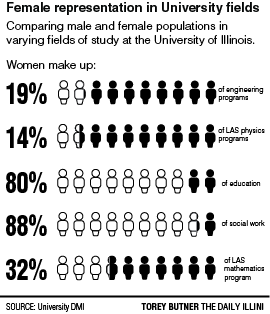A nation without equal representation
April 16, 2015
In the year 2015, we should all have some awareness of the pervasive disparity between men and women in our society. We are constantly reminded of the gender gap and its various manifestations in education, jobs and lifestyle.
With Deborah Frank Feinen being our newly elected Champaign mayor, Hillary Clinton officially announcing her 2016 presidential run and some advocating to get a woman on the $20 bill, it feels like we are on to something great for the future of women. Unfortunately, the truth and statistics out there don’t all say the same.
Despite the plethora of hurdles women have overcome in the United States these past several decades, there is still immense underrepresentation of women in our society in multiple respects. Considering women make up over half of the U.S. population, this is clearly a problem.
To throw some numbers out there for perspective: women hold less than 20 percent of seats in Congress, the U.S. ranks 98th in the world for percentage of women in national legislature and only 12 of the 100 largest U.S. cities have female mayors. Further, women make up only five percent of Fortune 500 chief executive officers, 15 percent of film writers, three percent of clout positions in mainstream media, 14.6 percent of executive officers, seven percent of directors of 250 top grossing domestic films — the list goes on.
For women to make up the majority of our population yet fill less than a quarter of various leadership roles in our country is troubling because it perpetuates the oppression of this social minority group. CEOs, government workers, managers and others are the voices of our industries, and we need to make sure these voices are representative of our population.
Get The Daily Illini in your inbox!
I don’t bring up these numbers with the intention that we need to meet some arbitrary quota of females in all of these settings. I don’t want to point to the fact that we have never had a female president as the sole reason to vote for Hillary Clinton. I don’t want to say that women should make up a specific percentage of CEOs. These would be band-aid solutions to numerically fix a problem instead of changing a surrounding culture.
Ultimately, I think we need to foster a culture that better encourages young girls to pursue male-dominated fields and positions based on their own merit and desire.
As stated in “Miss Representation,” a 2011 American documentary about sexism in society and media, “You can’t be what you can’t see.” It’s difficult to inspire a young woman to become U.S. president one day when she’s never seen a female president before. As the documentary also notes, at 7 years old, a roughly equal number of boys and girls say they want to be U.S. president one day. However, eight years later when asked the same question, the number of girls who say they want to one day be president declines immensely compared to boys.
This mentality applies to several other areas as well. In 2012, Forbes indicated that encouragement for young girls to pursue math and science is seldom, and there is an unconscious bias that these are “male” fields. The article further says these stereotypes constrain the likelihood of girls developing an interest in math and science.
Not surprisingly, we see the exhibition of this phenomenon at our own university. According to the University’s Division of Management Information for the spring 2015 semester, women make up about 19 percent of all engineering programs, 14 percent of the College of Liberal Arts and Science’s physics program and 32 percent of the mathematics program. These are shockingly low numbers when, for comparison, women make up 80 percent of education programs and 88 percent of social work programs.
We need women in male-dominated fields to bring new perspectives and talents into areas such as medicine and bioengineering. We need women to help find solutions to some of the world’s most fatal illnesses and design technologies to make our world more efficient. We need more female hands and voices to lead and change a world with numerous problems in need of solutions.
If we ever want to address these aforementioned issues, we need to foster an environment that puts all genders on the same playing field from day one.
We need to rethink our process of gender socialization and rework our approach to K-12 education. We need to continue with initiatives such as Like A Girl and GoldieBlox, which help eliminate some of the stereotypical gender differences. These initiatives give girls encouragement and inspiration to hopefully pursue presently male-dominated positions.
If we want young girls to one day become our next governors, presidents and faces of our currency, we need to promote a culture where women in these roles are no longer the exception.
Nicki is a senior in media.







